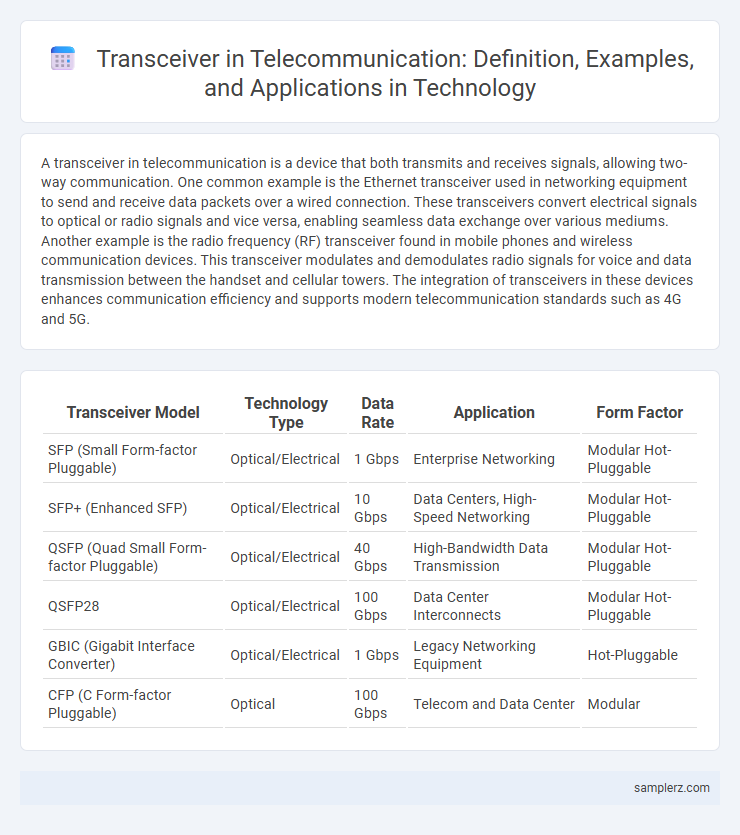A transceiver in telecommunication is a device that both transmits and receives signals, allowing two-way communication. One common example is the Ethernet transceiver used in networking equipment to send and receive data packets over a wired connection. These transceivers convert electrical signals to optical or radio signals and vice versa, enabling seamless data exchange over various mediums. Another example is the radio frequency (RF) transceiver found in mobile phones and wireless communication devices. This transceiver modulates and demodulates radio signals for voice and data transmission between the handset and cellular towers. The integration of transceivers in these devices enhances communication efficiency and supports modern telecommunication standards such as 4G and 5G.
Table of Comparison
| Transceiver Model | Technology Type | Data Rate | Application | Form Factor |
|---|---|---|---|---|
| SFP (Small Form-factor Pluggable) | Optical/Electrical | 1 Gbps | Enterprise Networking | Modular Hot-Pluggable |
| SFP+ (Enhanced SFP) | Optical/Electrical | 10 Gbps | Data Centers, High-Speed Networking | Modular Hot-Pluggable |
| QSFP (Quad Small Form-factor Pluggable) | Optical/Electrical | 40 Gbps | High-Bandwidth Data Transmission | Modular Hot-Pluggable |
| QSFP28 | Optical/Electrical | 100 Gbps | Data Center Interconnects | Modular Hot-Pluggable |
| GBIC (Gigabit Interface Converter) | Optical/Electrical | 1 Gbps | Legacy Networking Equipment | Hot-Pluggable |
| CFP (C Form-factor Pluggable) | Optical | 100 Gbps | Telecom and Data Center | Modular |
Cellular Network Transceivers: Key Components and Functions
Cellular network transceivers, including BTS (Base Transceiver Stations) and UE (User Equipment) transceivers, play a critical role in wireless communication by transmitting and receiving radio signals between mobile devices and network infrastructure. Key components such as RF amplifiers, modulators, demodulators, and oscillators ensure signal integrity, frequency conversion, and modulation essential for efficient data transmission in 4G and 5G networks. These transceivers enable real-time voice, data, and video transfer by managing duplex communication through time-division or frequency-division methods, optimizing network coverage and capacity.
Satellite Communication Transceivers Explained
Satellite communication transceivers enable bidirectional data transmission by converting radio signals into baseband signals and vice versa, essential for uplink and downlink communication. These transceivers operate across specific frequency bands such as C, Ku, and Ka bands to optimize signal clarity and minimize atmospheric interference. Advanced satellite transceivers integrate modulation, demodulation, power amplification, and error correction to maintain high data integrity and transmission efficiency over vast distances.
Wi-Fi Transceivers: Enabling Wireless Connectivity
Wi-Fi transceivers are essential components in wireless communication devices, enabling seamless data transmission and reception over IEEE 802.11 standards. These transceivers integrate radio frequency (RF) modules with baseband processing units to facilitate high-speed internet access in laptops, smartphones, and IoT devices. Advanced Wi-Fi transceivers support multiple input multiple output (MIMO) technology, enhancing range and throughput in congested wireless environments.
Optical Fiber Transceivers in Modern Networks
Optical fiber transceivers, such as SFP (Small Form-factor Pluggable) and QSFP (Quad Small Form-factor Pluggable), play a critical role in modern telecommunication networks by enabling high-speed data transmission over long distances with minimal signal loss. These transceivers convert electrical signals into optical signals and vice versa, supporting data rates from 1 Gbps to 400 Gbps, which are essential for backbone infrastructure and data center connectivity. Their compatibility with wavelength-division multiplexing (WDM) technology enhances network capacity and scalability in fiber-optic communication systems.
Bluetooth Transceivers for Short-Range Communication
Bluetooth transceivers enable efficient short-range wireless communication by transmitting and receiving radio frequency signals within the 2.4 GHz ISM band. These devices are integral to smartphones, wireless headphones, and IoT gadgets, supporting data rates up to 3 Mbps using Advanced Audio Distribution Profile (A2DP) and Low Energy (BLE) protocols. Their compact design and low power consumption optimize connectivity in personal area networks (PANs) across distances typically under 100 meters.
Radio Frequency Transceivers in IoT Devices
Radio Frequency (RF) transceivers in IoT devices enable wireless communication by transmitting and receiving signals within specific frequency bands, such as 2.4 GHz for Wi-Fi and Bluetooth or sub-GHz frequencies for long-range communication like LoRa. These transceivers integrate key components including power amplifiers, mixers, and low-noise amplifiers to ensure efficient signal processing and energy consumption in compact IoT sensors and modules. Optimized RF transceivers support seamless connectivity, low latency, and extended battery life critical for smart home systems, industrial automation, and remote monitoring applications.
Microwave Transceivers: Applications and Advantages
Microwave transceivers play a pivotal role in telecommunication by enabling high-frequency signal transmission for wireless communication systems, radar, and satellite links. Their advantages include high data transfer rates, minimal signal attenuation, and resistance to electromagnetic interference, making them essential for long-distance and line-of-sight communication. Applications span from cellular base stations and point-to-point microwave links to aerospace and military communication systems, where reliability and performance are critical.
Two-Way Radio Transceivers for Emergency Services
Two-way radio transceivers used in emergency services enable instant, reliable communication between first responders, enhancing coordination during critical situations. These devices often operate on dedicated frequencies with robust encryption to ensure secure and clear transmissions in high-interference environments. Models like the Motorola APX series are specifically designed for public safety, providing features such as rugged construction, extended battery life, and interoperability with other communication systems.
Software-Defined Radio (SDR) Transceivers: Flexibility in Telecom
Software-Defined Radio (SDR) transceivers exemplify cutting-edge flexibility in telecommunication by enabling dynamic reconfiguration of modulation schemes, frequencies, and protocols through software updates. SDR transceivers support multiple communication standards such as LTE, 5G, and Wi-Fi on a single hardware platform, reducing infrastructure costs and accelerating deployment. Their adaptability enhances spectrum efficiency and network interoperability, paving the way for smarter, more resilient telecom systems.
5G NR Transceivers: Powering Next-Gen Mobile Networks
5G NR transceivers operate within millimeter-wave and sub-6 GHz frequency bands, enabling ultra-high-speed data transmission and low latency required for next-generation mobile networks. These transceivers integrate advanced technologies such as massive MIMO and beamforming to enhance signal quality and spectral efficiency. Power-efficient design and robust RF front-end modules ensure reliable connectivity in diverse 5G environments, driving enhanced user experiences and IoT applications.

example of transceiver in telecommunication Infographic
 samplerz.com
samplerz.com